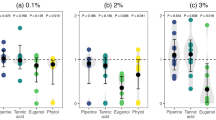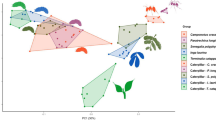Abstract
The impact of different diets on chemical defense has been extensively studied in animals that sequester defensive chemicals from food. However, there are fewer studies of diet-mediated variation in autogenously produced defenses. Ladybird beetles, which use autogenously synthesized defensive alkaloids, are used as models in a wide diversity of studies of chemical defense, specifically in studies of intraspecific variation in color pattern and chemical defense. Many aphidophagous ladybirds consume a wide diversity of aphid prey, which vary in quality and thus could affect the synthesis of chemical defense. We measured alkaloid recovery rate after reflex bleeding by the ladybird Adalia bipunctata on two different aphid diets, the high quality Acyrthosiphon pisum and the lower quality Aphis fabae. Alkaloids reaccumulated in ladybirds more slowly when they were fed A. fabae than when they were fed A. pisum and females generally had more alkaloid than males, but reaccumulated alkaloid more slowly. Recovery times were more than 12 days. There appeared to be a weak positive relationship between alkaloid level and time since reflex bleeding for eggs of A. pisum- but not A. fabae-fed females. Our findings on diet and alkaloid synthesis in ladybirds suggest that chemical defense levels are very dynamic, indicating that studies conducted at a single point in time, such as those focused on ladybird color pattern, fail to consider a wide diversity of temporal variation that occurs in the field. This is likely true for many autogenously produced chemical defense systems in a diversity of other organisms.




Similar content being viewed by others
Data Availability
Not applicable.
Code Availability
Not applicable.
References
Agrawal AA, Böröczky K, Haribal M, Hastings AP, White RA, Jiang R-W, Duplais C (2021) Cardenolides, toxicity, and the costs of sequestration in the coevolutionary interaction between monarchs and milkweeds. PNAS 118:e2024463118. https://doi.org/10.1073/pnas.2024463118
Arenas LM, Walter D, Stevens M (2015) Signal honesty and predation risk among a closely related group of aposematic species. Sci Rep 5:11021. https://doi.org/10.1038/srep11021
Attygalle AB, Blankespoor CL, Eisner T, Meinwald J (1994) Biosynthesis of a defensive insect alkaloid: epilachnene from oleic acid and serine. PNAS 91:12790–12793. https://doi.org/10.1073/pnas.91.26.12790
Banks CJ (1955) An ecological study of Coccinellidae (Col.) associated with Aphis fabae Scop. on Vicia faba. Bull Entomol Res 46:561–587. https://doi.org/10.1017/S0007485300039559
Bayoumy MH, Osawa N, Hatt S (2020) Fitness costs of reflex bleeding in the ladybird beetle Harmonia axyridis: the role of parental effects. Insect Sci 27:1346–1356. https://doi.org/10.1111/1744-7917.12737
Bezzerides AL, McGraw KJ, Parker RS, Husseini J (2007) Elytra color as a signal of chemical defense in the Asian ladybird beetle Harmonia axyridis. Behav Ecol Sociobiol 61:1401–1408. https://doi.org/10.1007/s00265-007-0371-9
Blackman RL (1965) Studies on specificity in Coccinellidae. Ann Appl Biol 56:336–338. https://doi.org/10.1111/j.1744-7348.1965.tb01249.x
Blackman RL (1967) The effects of different aphid foods on Adalia bipunctata L. and Coccinella 7-punctata L. Ann Appl Biol 59:207–219. https://doi.org/10.1111/j.1744-7348.1967.tb04429.x
Blount JD, Rowland HM, Drijfhout FP, Endler JA, Inger R, Sloggett JJ, Hurst GDD, Hodgson DJ, Speed MP (2012) How the ladybird got its spots: effects of resource limitation on the honesty of aposematic signals. Funct Ecol 26:334–342. https://doi.org/10.1111/j.1365-2435.2012.01961.x
Brower LP, Seiber JN, Nelson CJ, Lynch SP, Tuskes PM (1982) Plant-determined variation in the cardenolide content, thin-layer chromatography profiles, and emetic potency of monarch butterflies, Danaus plexippus reared on the milkweed, Asclepias eriocarpa in California. J Chem Ecol 8:579–633. https://doi.org/10.1007/BF00989631
Brückner A, Heethoff M (2018) Nutritional effects on chemical defense alter predator–prey dynamics. Chemoecology 28:1–9. https://doi.org/10.1007/s00049-018-0253-9
Daloze D, Braekman J-C, Pasteels JM (1995) Ladybird defence alkaloids: Structural, chemotaxonomic and biosynthetic aspects (Col.: Coccinellidae). Chemoecology 5/6:173–183. https://doi.org/10.1007/bf01240602
El-Hariri G (1966a) Changes in metabolic reserves of three species of aphidophagous Coccinellidae (Coleoptera) during metamorphosis. Entomol Exp Appl 9:349–358. https://doi.org/10.1111/j.1570-7458.1966.tb00992.x
El-Hariri G (1966b) Laboratory studies on the reproduction of Adalia bipunctata (Coleoptera, Coccinellidae). Entomol Exp Appl 9:200–204. https://doi.org/10.1111/j.1570-7458.1966.tb02349.x
Grill CP, Moore AJ (1998) Effects of a larval antipredator response and larval diet on adult phenotype in an aposematic ladybird beetle. Oecologia 114:274–282. https://doi.org/10.1007/s004420050446
Happ GM, Eisner T (1961) Hemorrhage in a coccinellid beetle and its repellent effect on ants. Science 134:329–331. https://doi.org/10.1126/science.134.3475.329
Haulotte E, Laurent P, Braekman J-C (2012) Biosynthesis of defensive Coccinellidae alkaloids: Incorporation of fatty acids in adaline, coccinelline, and harmonine. Eur J Org Chem 2012:1907–1912. https://doi.org/10.1002/ejoc.201101563
Hautier L, Grégoire J-C, de Schauwers J, San Martin G, Callier P, Jansen J-P, de Biseau J-C (2008) Intraguild predation by Harmonia axyridis on coccinellids revealed by exogenous alkaloid sequestration. Chemoecology 18:191–196. https://doi.org/10.1007/s00049-008-0405-4
Heethoff M (2012) Regeneration of complex oil-gland secretions and its importance for chemical defense in an oribatid mite. J Chem Ecol 38:1116–1123. https://doi.org/10.1007/s10886-012-0169-8
Hemptinne J-L, Dixon AFG, Gauthier C (2000) Nutritive cost of intraguild predation on eggs of Coccinella septempunctata and Adalia bipunctata (Coleoptera: Coccinellidae). Eur J Entomol 97:559–562. https://doi.org/10.14411/eje.2000.087
Hodek I, Evans EW (2012) Food Relationships. In: Hodek I, van Emden H, Honěk A (eds) Ecology and Behaviour of the Ladybird Beetles (Coccinellidae). Wiley-Blackwell, Chichester, pp 141–274. https://doi.org/10.1002/9781118223208.ch5
Holliday AE, Walker FM, Brodie ED III, Formica VA (2009) Differences in defensive volatiles of the forked fungus beetle, Bolitotherus cornutus, living on two species of fungus. J Chem Ecol 35:1302–1308. https://doi.org/10.1007/s10886-009-9712-7
Holloway GJ, de Jong PW, Ottenheim M (1993) The genetics and cost of chemical defense in the two-spot ladybird (Adalia bipunctata. L). Evolution 47:1229–1239. https://doi.org/10.1111/j.1558-5646.1993.tb02149.x
Holloway GJ, de Jong PW, Brakefield PM, de Vos H (1991) Chemical defence in ladybird beetles (Coccinellidae). I. Distribution of coccinelline and individual variation in defence in 7-spot ladybirds (Coccinella septempunctata). Chemoecology 2:7–14. https://doi.org/10.1007/bf01240660
Jared SGS, Jared C, Egami MI, Mailho-Fontana PL, Rodrigues MT, Antoniazzi MM (2014) Functional assessment of toad parotoid macroglands: A study based on poison replacement after mechanical compression. Toxicon 87:92–103. https://doi.org/10.1016/j.toxicon.2014.05.020
Jones CG, Hess TA, Whitman DW, Silk PJ, Blum MS (1987) Effects of diet breadth on autogenous chemical defense of a generalist grasshopper. J Chem Ecol 13:283–297. https://doi.org/10.1007/BF01025888
de Jong PW, Holloway GJ, Brakefield PM, de Vos H (1991) Chemical defence in ladybird beetles (Coccinellidae). II. Amount of reflex fluid, the alkaloid adaline and individual variation in defence in 2-spot ladybirds (Adalia bipunctata). Chemoecology 2:15–19. https://doi.org/10.1007/bf01240661
Kajita Y, Obrycki JJ, Sloggett JJ, Haynes KF (2010) Intraspecific alkaloid variation in ladybird eggs and its effects on con- and hetero-specific intraguild predators. Oecologia 163:313–322. https://doi.org/10.1007/s00442-009-1551-2
Kendall DA (1971) A note on reflex bleeding in the larvae of the beetle Exochomus quadripustulatus (L.) (Col.: Coccinellidae). The Entomologist 104:233–235
King AG, Meinwald J (1996) Review of the defensive chemistry of coccinellids. Chem Rev 96:1105–1122. https://doi.org/10.1021/cr950242v
Knapp M, Dobeš P, Řeřicha M, Hyršl P (2018) Puncture vs. reflex bleeding: Haemolymph composition reveals significant differences among ladybird species (Coleoptera: Coccinellidae), but not between sampling methods. Eur J Entomol 115:1–6. https://doi.org/10.14411/eje.2018.001
Lampert EC, Bowers MD (2010) Host plant influences on iridoid glycoside sequestration of generalist and specialist caterpillars. J Chem Ecol 36:1101–1104. https://doi.org/10.1007/s10886-010-9849-4
Laurent P, Braekman J-C, Daloze D (2005) Insect Chemical Defense. In: Schulz S (ed) The Chemistry of pheromones and other semiochemicals II. (Topics in Current Chemistry 240). Springer Berlin Heidelberg, Berlin, Heidelberg, pp 167–229. https://doi.org/10.1007/b98317
Laurent P, Braekman J-C, Daloze D, Pasteels JM (2002) In vitro production of adaline and coccinelline, two defensive alkaloids from ladybird beetles (Coleoptera: Coccinellidae). Insect Biochem Molec Biol 32:1017–1023. https://doi.org/10.1016/s0965-1748(02)00038-3
Laurent P, Lebrun B, Braekman J-C, Daloze D, Pasteels JM (2001) Biosynthetic studies on adaline and adalinine, two alkaloids from ladybird beetles (Coleoptera: Coccinellidae). Tetrahedron 57:3403–3412. https://doi.org/10.1016/s0040-4020(01)00207-1
Lognay G, Hemptinne JL, Chan FY, Gaspar C, Marlier M, Braekman J-C, Daloze D, Pasteels JM (1996) Adalinine, a new piperidine alkaloid from the ladybird beetles Adalia bipunctata and Adalia decempunctata. J Nat Prod 59:510–511. https://doi.org/10.1021/np960129f
Majerus MEN (1994) Ladybirds. HarperCollins, London
Majerus MEN, Kearns PWE, Forge H, Ireland H (1989) Ladybirds as teaching aids: 1 Collecting and culturing. J Biol Educ 23:85–95. https://doi.org/10.1080/00219266.1989.9655039
Marples NM (1993) Is the alkaloid in 2spot ladybirds (Adalia bipunctata) a defence against ant predation? Chemoecology 4:29–32. https://doi.org/10.1007/bf01245893
Marples NM, Brakefield PM, Cowie RJ (1989) Differences between the 7-spot and 2-spot ladybird beetles (Coccinellidae) in their toxic effects on a bird predator. Ecol Entomol 14:79–84. https://doi.org/10.1111/j.1365-2311.1989.tb00756.x
Pasteels JM, Deroe C, Tursch B, Braekman J-C, Daloze D, Hootele C (1973) Distribution et activités des alcaloïdes défensifs des Coccinellidae. J Insect Physiol 19:1771–1784. https://doi.org/10.1016/0022-1910(73)90046-2
R Core Team (2013) R: A language and environment for statistical computing.
Ramos CS, Ramos NSM, Da Silva RR, Da Câmara CAG, Almeida AV (2012) Metabolism by grasshoppers of volatile chemical constituents from Mangifera indica and Solanum paniculatum leaves. J Insect Physiol 58:1663–1668. https://doi.org/10.1016/j.jinsphys.2012.10.007
Rana JS, Dixon AFG, Jarošik V (2002) Costs and benefits of prey specialization in a generalist insect predator. J Anim Ecol 71:15–22. https://doi.org/10.1046/j.0021-8790.2001.00574.x
Randall K, Majerus M, Forge H (1992) Characteristics for sex determination in British ladybirds (Coleoptera: Coccinellidae). The Entomologist 111:109–122
Rossini C, Attygalle AB, González A, Smedley SR, Eisner M, Meinwald J, Eisner T (1997) Defensive production of formic acid (80%) by a carabid beetle (Galerita lecontei). PNAS 94:6792–6797. https://doi.org/10.1073/pnas.94.13.6792
Ruxton GD, Allen WL, Sherratt TN, Speed MP (2018) Avoiding Attack: The Evolutionary Ecology of Crypsis, Aposematism, and Mimicry. 2nd edn. Oxford University Press, Oxford. https://doi.org/10.1093/oso/9780199688678.001.0001
Sloggett JJ, Haynes KF, Obrycki JJ (2009) Hidden costs to an invasive intraguild predator from chemically defended native prey. Oikos 118:1396–1404. https://doi.org/10.1111/j.1600-0706.2009.17407.x
Speed MP, Ruxton GD, Mappes J, Sherratt TN (2012) Why are defensive toxins so variable? An evolutionary perspective. Biol Rev 87:874–884. https://doi.org/10.1111/j.1469-185X.2012.00228.x
Steele T, Singer RD, Bjørnson S (2020a) Effects of temperature on larval development, alkaloid production and microsporidiosis in the two-spotted lady beetle, Adalia bipunctata L. (Coleoptera: Coccinellidae). J Invertebr Pathol 172:107353. https://doi.org/10.1016/j.jip.2020.107353
Steele T, Singer RD, Bjørnson S (2020b) Effects of food availability on microsporidiosis and alkaloid production in the two-spotted lady beetle. Adalia Bipunctata L. J Invertebr Pathol 175:107443. https://doi.org/10.1016/j.jip.2020.107443
Tursch B, Braekman J-C, Daloze D, Hootele C, Losman D, Karlsson R, Pasteels JM (1973) Chemical ecology of arthropods, VI. Adaline, a novel alkaloid from Adalia bipunctata L, (Coleoptera, Coccinellidae). Tetrahedron Lett 14:201–202. https://doi.org/10.1016/S0040-4039(01)95617-5
Wheeler CA, Millar JG, Cardé RT (2015) Multimodal signal interactions in the ladybeetle, Hippodamia convergens, aposematic system. Chemoecology 25:123–133. https://doi.org/10.1007/s00049-014-0181-2
Winters AE, Stevens M, Mitchell C, Blomberg SP, Blount JD (2014) Maternal effects and warning signal honesty in eggs and offspring of an aposematic ladybird beetle. Funct Ecol 28:1187–1196. https://doi.org/10.1111/1365-2435.12266
Zvereva EL, Kozlov MV (2016) The costs and effectiveness of chemical defenses in herbivorous insects: a meta-analysis. Ecol Monogr 86:107–124. https://doi.org/10.1890/15-0911.1
Acknowledgements
We thank Solène Blanchard and François Verheggen for providing the starting culture of Aphis fabae. We thank Marie Correia for technical advice, Fokko Zandbergen, Paul Lemmens, and Tobie van Zwieten for laboratory support, and Hanne Diliën for her comments on this work. This research was partially supported by Universiteitsfonds Limburg (SWOL) (Grant:CoBes18.010-VT).
Funding
Universteitsfonds Limburg (CoBes18.010-VT).
Author information
Authors and Affiliations
Contributions
ZO and JJS formulated the idea and developed the methodology. ZO conducted the experiments and statistical analysis, with advice from JJS. ZO and JJS wrote the manuscript.
Corresponding author
Ethics declarations
Ethics Approval
Not applicable.
Consent to Participate
Not applicable.
Consent for Publication
Not applicable.
Conflicts of Interest/Competing Interests
The authors declare no competing interests.
Supplementary Information
Below is the link to the electronic supplementary material.
Rights and permissions
About this article
Cite this article
Oudendijk, Z., Sloggett, J.J. How Diet Leads to Defensive Dynamism: Effect of the Dietary Quality on Autogenous Alkaloid Recovery Rate in a Chemically Defended Beetle. J Chem Ecol 48, 99–107 (2022). https://doi.org/10.1007/s10886-021-01326-2
Received:
Revised:
Accepted:
Published:
Issue Date:
DOI: https://doi.org/10.1007/s10886-021-01326-2




